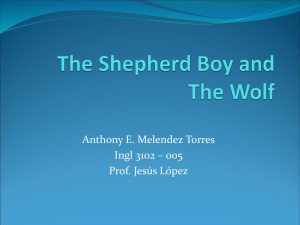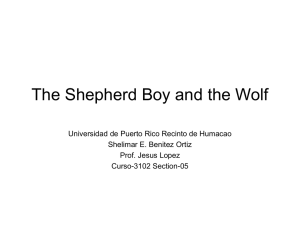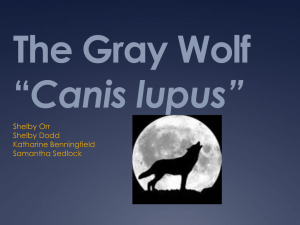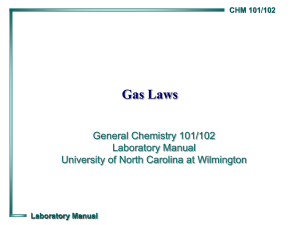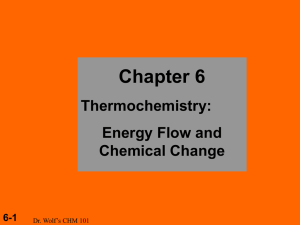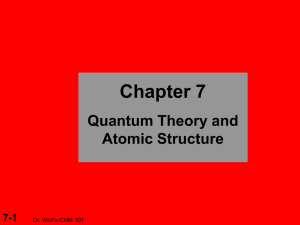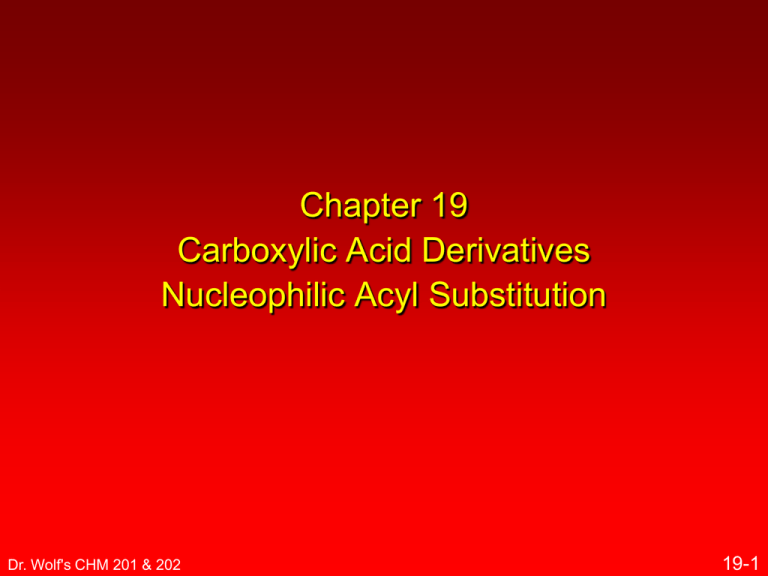
Chapter 19
Carboxylic Acid Derivatives
Nucleophilic Acyl Substitution
Dr. Wolf's CHM 201 & 202
19-1
Nomenclature of Carboxylic Acid Derivatives
Dr. Wolf's CHM 201 & 202
19-2
Acyl Halides
O
RC
X
name the acyl group and add the word chloride,
fluoride, bromide, or iodide as appropriate
acyl chlorides are, by far, the most frequently
encountered of the acyl halides
Dr. Wolf's CHM 201 & 202
19-3
Acyl Halides
O
acetyl chloride
CH3CCl
O
H2C
CHCH2CCl
3-butenoyl chloride
O
F
Dr. Wolf's CHM 201 & 202
CBr
p-fluorobenzoyl bromide
19-4
Acid Anhydrides
O O
RCOCR'
when both acyl groups are the same, name the
acid and add the word anhydride
when the groups are different, list the names of the
corresponding acids in alphabetical order and add
the word anhydride
Dr. Wolf's CHM 201 & 202
19-5
Acid Anhydrides
O O
CH3COCCH3
acetic anhydride
O O
C6H5COCC6H5
benzoic anhydride
O O
C6H5COC(CH2)5CH3
Dr. Wolf's CHM 201 & 202
benzoic heptanoic anhydride
19-6
Esters
O
RCOR'
name as alkyl alkanoates
cite the alkyl group attached to oxygen first (R')
name the acyl group second; substitute the suffix
-ate for the -ic ending of the corresponding acid
Dr. Wolf's CHM 201 & 202
19-7
Esters
O
CH3COCH2CH3
ethyl acetate
O
CH3CH2COCH3
methyl propanoate
O
COCH2CH2Cl
Dr. Wolf's CHM 201 & 202
2-chloroethyl benzoate
19-8
Amides having an NH2 group
O
RCNH2
identify the corresponding carboxylic acid
replace the -ic acid or -oic acid ending by -amide.
Dr. Wolf's CHM 201 & 202
19-9
Amides having an NH2 group
O
CH3CNH2
acetamide
O
(CH3)2CHCH2CNH2
3-methylbutanamide
O
CNH2
Dr. Wolf's CHM 201 & 202
benzamide
19-10
Amides having substituents on N
O
RCNHR'
O
and
RCNR'2
name the amide as before
precede the name of the amide with the name of
the appropriate group or groups
precede the names of the groups by the letter N(standing for nitrogen and used as a locant)
Dr. Wolf's CHM 201 & 202
19-11
Amides having substituents on N
O
N-methylacetamide
CH3CNHCH3
O
CN(CH2CH3)2
N,N-diethylbenzamide
O
CH3CH2CH2CNCH(CH3)2
CH3
Dr. Wolf's CHM 201 & 202
N-isopropyl-N-methylbutanamide
19-12
Nitriles
RC
N
add the suffix -nitrile to the name of the parent
hydrocarbon chain (including the triply bonded
carbon of CN)
or: replace the -ic acid or -oic acid name of the
corresponding carboxylic acid by -onitrile
or: name as an alkyl cyanide (functional class
name)
Dr. Wolf's CHM 201 & 202
19-13
Nitriles
CH3C
C6H5C
N
N
CH3CHCH3
C
Dr. Wolf's CHM 201 & 202
N
ethanenitrile
or: acetonitrile
or: methyl cyanide
benzonitrile
2-methylpropanenitrile
or: isopropyl cyanide
19-14
Structure of Carboxylic Acid Derivatives
Dr. Wolf's CHM 201 & 202
19-15
The key to this chapter is the next
slide.
It lists the various carboxylic acids in
order of decreasing reactivity toward
their fundamental reaction type
(nucleophilic acyl substitution).
The other way to read the list is in
order of increasing stabilization of the
carbonyl group.
Dr. Wolf's CHM 201 & 202
19-16
Most
reactive
O
CH3C
O
CH3C
Cl
Least
stabilized
O
OCCH3
O
CH3C
SCH2CH3
O
CH3C
Least
reactive
OCH2CH3
O
CH3C
Dr. Wolf's CHM 201 & 202
NH2
Most
stabilized
19-17
Electron Delocalization and the Carbonyl Group
The main structural feature that distinguishes acyl
chlorides, anhydrides, thioesters, esters, and
amides is the interaction of the substituent with the
carbonyl group. It can be represented in
resonance terms as:
•• –
•• O ••
••
O ••
RC
••
X
Dr. Wolf's CHM 201 & 202
RC
+
•• –
•• O ••
••
X
RC
+
X
19-18
Electron Delocalization and the Carbonyl Group
The extent to which the lone pair on X can be
delocalized into C=O depends on:
1) the electronegativity of X
2) how well the lone pair orbital of X interacts
with the orbital of C=O
••
•• –
•• –
•• O ••
•• O ••
O ••
RC
••
X
Dr. Wolf's CHM 201 & 202
RC
+
••
X
RC
+
X
19-19
Orbital overlaps in carboxylic acid derivatives
orbital of carbonyl group
Dr. Wolf's CHM 201 & 202
19-20
Orbital overlaps in carboxylic acid derivatives
lone pair orbital
of substituent
Dr. Wolf's CHM 201 & 202
19-21
Orbital overlaps in carboxylic acid derivatives
electron pair of substituent delocalized into
carbonyl orbital
Dr. Wolf's CHM 201 & 202
19-22
Acyl Chlorides
•• –
•• O ••
••
O ••
R
C
•• Cl ••
••
R
C
•• Cl +
••
acyl chlorides have the least stabilized carbonyl
group
delocalization of lone pair of Cl into C=O group is
not effective because C—Cl bond is too long
Dr. Wolf's CHM 201 & 202
19-23
least stabilized C=O
O
RCCl
most stabilized C=O
Dr. Wolf's CHM 201 & 202
19-24
Acid Anhydrides
••
O ••
R
C
O ••
– ••
•• O ••
C
C
••
••
O
••
R
R
••
O ••
+
O
C
••
R
lone pair donation from oxygen stabilizes the
carbonyl group of an acid anhydride
the other carbonyl group is stabilized in an
analogous manner by the lone pair
Dr. Wolf's CHM 201 & 202
19-25
least stabilized C=O
O
RCCl
O O
RCOCR'
most stabilized C=O
Dr. Wolf's CHM 201 & 202
19-26
Thioesters
– ••
•• O ••
••
O ••
R
C
••
SR'
••
R
C
+
SR'
••
Sulfur (like chlorine) is a third-row element.
Electron donation to C=O from third-row elements
is not very effective.
Resonance stabilization of C=O in thioesters is
not significant.
Dr. Wolf's CHM 201 & 202
19-27
least stabilized C=O
O
RCCl
O O
RCOCR'
O
RCSR'
most stabilized C=O
Dr. Wolf's CHM 201 & 202
19-28
Esters
– ••
•• O ••
••
O ••
R
C
••
OR'
••
R
C
+
OR'
••
lone pair donation from oxygen stabilizes the
carbonyl group of an ester
stabilization greater than comparable stabilization
of an anhydride or thioester
Dr. Wolf's CHM 201 & 202
19-29
least stabilized C=O
O
RCCl
O O
RCOCR'
O
RCSR'
O
RCOR'
most stabilized C=O
Dr. Wolf's CHM 201 & 202
19-30
Amides
– ••
•• O ••
••
O ••
R
C
••
NR'2
R
C
+
NR'2
lone pair donation from nitrogen stabilizes the
carbonyl group of an amide
N is less electronegative than O; therefore,
amides are stabilized more than esters and
anhydrides
Dr. Wolf's CHM 201 & 202
19-31
Amides
– ••
•• O ••
••
O ••
R
C
••
NR'2
R
C
+
NR'2
amide resonance imparts significant double-bond
character to C—N bond
activation energy for rotation about C—N bond
is 75-85 kJ/mol
C—N bond distance is 135 pm in amides versus
normal single-bond distance of 147 pm in amines
Dr. Wolf's CHM 201 & 202
19-32
least stabilized C=O
O
RCCl
O O
RCOCR'
O
RCSR'
O
RCOR'
O
RCNR'2
most stabilized C=O
Dr. Wolf's CHM 201 & 202
19-33
Carboxylate ions
– ••
•• O ••
••
O ••
R
C
•• –
O ••
••
R
C
O ••
••
very efficient electron delocalization and dispersal
of negative charge
maximum stabilization
Dr. Wolf's CHM 201 & 202
19-34
least stabilized C=O
O
RCCl
O O
RCOCR'
O
RCSR'
O
RCOR'
O
RCNR'2
O
RCO–
most stabilized C=O
Dr. Wolf's CHM 201 & 202
19-35
Reactivity is related to structure
Stabilization
Relative rate
of hydrolysis
RCCl
O O
very small
1011
RCOCR'
small
107
RCOR'
O
moderate
1.0
RCNR'2
large
< 10-2
O
O
Dr. Wolf's CHM 201 & 202
The more
stabilized the
carbonyl group,
the less reactive
it is.
19-36
Nucleophilic Acyl Substitution
In general:
••
••
O ••
R
C
O ••
+
X
HY
R
C
+
HX
Y
Reaction is feasible when a less stabilized
carbonyl is converted to a more stabilized
one (more reactive to less reactive).
Dr. Wolf's CHM 201 & 202
19-37
most reactive
O
RCCl
O O
RCOCR'
O
RCSR'
a carboxylic acid
derivative can be
converted by
nucleophilic acyl
substitution to any other
type that lies below it in
this table
Dr. Wolf's CHM 201 & 202
O
RCOR'
O
RCNR'2
O
RCO–
least reactive
19-38
General Mechanism
for
Nucleophilic Acyl Substitution
Dr. Wolf's CHM 201 & 202
19-39
Nucleophilic Acyl Substitution
••
••
O ••
R
C
O ••
+
X
HNu
R
C
+
HX
Nu
Reaction is feasible when a less stabilized
carbonyl is converted to a more stabilized
one (more reactive to less reactive).
Dr. Wolf's CHM 201 & 202
19-40
General Mechanism for Nucleophilic Acyl Substitution
involves formation and dissociation
of a tetrahedral intermediate
••
R
C
••
OH
O ••
HNu
O ••
-HX
R
C
X
Nu
R
C
Nu
X
Both stages can involve several elementary steps.
Dr. Wolf's CHM 201 & 202
19-41
General Mechanism for Nucleophilic Acyl Substitution
first stage of mechanism (formation of tetrahedral
intermediate) is analogous to nucleophilic addition
to C=O of aldehydes and ketones
••
OH
O ••
R
C
HNu
R
C
X
Nu
X
Dr. Wolf's CHM 201 & 202
19-42
General Mechanism for Nucleophilic Acyl Substitution
second stage is restoration of C=O by elimination
complicating features of each stage involve
acid-base chemistry
••
R
C
••
OH
O ••
HNu
O ••
-HX
R
C
X
Nu
R
C
Nu
X
Dr. Wolf's CHM 201 & 202
19-43
General Mechanism for Nucleophilic Acyl Substitution
Acid-base chemistry in first stage is familiar in that
it has to do with acid/base catalysis of nucleophilic
addition to C=O.
••
R
C
••
OH
O ••
HNu
O ••
-HX
R
C
X
Nu
R
C
Nu
X
Dr. Wolf's CHM 201 & 202
19-44
General Mechanism for Nucleophilic Acyl Substitution
Acid-base chemistry in second stage concerns
form in which the tetrahedral intermediate exists
under the reaction conditions and how it dissociates
under those conditions.
••
R
C
••
OH
O ••
HNu
O ••
-HX
R
C
X
Nu
R
C
Nu
X
Dr. Wolf's CHM 201 & 202
19-45
The Tetrahedral Intermediate
tetrahedral intermediate (TI)
••
H O ••
R
H
R
O ••
•X
•
C
H
C
••
Nu ••
X+
Conjugate acid of tetrahedral
intermediate (TI+)
Dr. Wolf's CHM 201 & 202
Nu ••
R
– ••
• O ••
•
C
Nu ••
•• X
Conjugate base of tetrahedral
intermediate (TI–)
19-46
Dissociation of TI—H+
B ••
H
R
••
O ••
C
X
+
H
•• Nu
••
+B—H
O ••
+
R
Dr. Wolf's CHM 201 & 202
C
+
•X
•
H
Nu ••
19-47
Dissociation of TI
B ••
H
R
••
O ••
C
X••
•• Nu
••
+B—H
O ••
+
R
Dr. Wolf's CHM 201 & 202
C
+
• X •–
• •
Nu ••
19-48
Dissociation of TI–
•• –
•• O
••
R
X••
C
•• Nu
••
O ••
R
Dr. Wolf's CHM 201 & 202
C
+
• X •–
• •
Nu ••
19-49
Nucleophilic Substitution
in Acyl Chlorides
Dr. Wolf's CHM 201 & 202
19-50
Preparation of Acyl Chlorides
from carboxylic acids and thionyl chloride
(Section 12.7)
O
(CH3)2CHCOH
O
SOCl2
heat
(CH3)2CHCCl + SO2 + HCl
(90%)
Dr. Wolf's CHM 201 & 202
19-51
Reactions of Acyl Chlorides
O
RCCl
O O
RCOCR'
O
RCOR'
O
RCNR'2
O
RCO–
Dr. Wolf's CHM 201 & 202
19-52
Reactions of Acyl Chlorides
Acyl chlorides react with carboxylic acids to give
acid anhydrides:
O
O O
O
RCCl + R'COH
RCOCR'
+
HCl
H
via:
R
O
O
C
OCR'
Cl
Dr. Wolf's CHM 201 & 202
19-53
Example
O
O
CH3(CH2)5CCl +
CH3(CH2)5COH
pyridine
O O
CH3(CH2)5COC(CH2)5CH3
(78-83%)
Dr. Wolf's CHM 201 & 202
19-54
Reactions of Acyl Chlorides
Acyl chlorides react with alcohols to give esters:
O
O
RCCl + R'OH
RCOR'
+
HCl
H
O
via:
R
C
OR'
Cl
Dr. Wolf's CHM 201 & 202
19-55
Example
O
O
C6H5CCl + (CH3)3COH
pyridine
C6H5COC(CH3)3
(80%)
Dr. Wolf's CHM 201 & 202
19-56
Reactions of Acyl Chlorides
Acyl chlorides react with ammonia and amines
to give amides:
O
O
RCCl + R'2NH + HO–
RCNR'2 + H2O
H
+ Cl–
O
via:
R
C
NR'2
Cl
Dr. Wolf's CHM 201 & 202
19-57
Example
O
O
C6H5CCl + HN
NaOH
H2O
C6H5CN
(87-91%)
Dr. Wolf's CHM 201 & 202
19-58
Reactions of Acyl Chlorides
Acyl chlorides react with water to give
carboxylic acids (carboxylate ion in base):
O
RCCl + H2O
O
RCCl + 2HO–
O
RCOH
+
HCl
+
Cl–
O
RCO–
+ H2O
Dr. Wolf's CHM 201 & 202
19-59
Reactions of Acyl Chlorides
Acyl chlorides react with water to give
carboxylic acids (carboxylate ion in base):
O
O
RCCl + H2O
RCOH
+
HCl
H
O
via:
R
C
OH
Cl
Dr. Wolf's CHM 201 & 202
19-60
Example
O
C6H5CH2CCl + H2O
Dr. Wolf's CHM 201 & 202
O
C6H5CH2COH + HCl
19-61
Reactivity
Acyl chlorides undergo nucleophilic
substitution much faster than alkyl chlorides.
O
C6H5CCl
Relative rates of
hydrolysis (25°C)
Dr. Wolf's CHM 201 & 202
1,000
C6H5CH2Cl
1
19-62
Nucleophilic Acyl Substitution in
Carboxylic Acid Anhydrides
Anhydrides can be prepared from acyl
chlorides as described in Table 20.1
Dr. Wolf's CHM 201 & 202
19-63
Some anhydrides are industrial chemicals
O O
O
O
CH3COCCH3
O
Acetic
anhydride
Dr. Wolf's CHM 201 & 202
Phthalic
anhydride
O
O
O
Maleic
anhydride
19-64
From dicarboxylic acids
Cyclic anhydrides with 5- and 6-membered
rings can be prepared by dehydration of
dicarboxylic acids
O
H
COH
C
H
C
H
tetrachloroethane
O
130°C
COH
O
Dr. Wolf's CHM 201 & 202
O
H
+ H2 O
O
(89%)
19-65
Reactions of Anhydrides
O O
RCOCR'
O
RCOR'
O
RCNR'2
O
RCO–
Dr. Wolf's CHM 201 & 202
19-66
Reactions of Acid Anhydrides
Carboxylic acid anhydrides react with alcohols
to give esters:
O O
RCOCR + R'OH
O
RCOR'
O
+ RCOH
normally, symmetrical anhydrides are used
(both R groups the same)
reaction can be carried out in presence of
pyridine (a base) or it can be catalyzed by acids
Dr. Wolf's CHM 201 & 202
19-67
Reactions of Acid Anhydrides
Carboxylic acid anhydrides react with alcohols
to give esters:
O
O O
RCOCR + R'OH
RCOR'
O
+ RCOH
H
O
via:
R
OR'
C
OCR
Dr. Wolf's CHM 201 & 202
O
19-68
Example
O O
CH3COCCH3
+ CH3CHCH2CH3
OH
H2SO4
O
CH3COCHCH2CH3
(60%)
CH3
Dr. Wolf's CHM 201 & 202
19-69
Reactions of Acid Anhydrides
Acid anhydrides react with ammonia and amines
to give amides:
O
O O
RCOCR
RCNR'2 + RCO–
+ 2R'2NH
H
+
R'2NH2
O
via:
O
R
NR'2
C
OCR
O
Dr. Wolf's CHM 201 & 202
19-70
Example
O O
CH3COCCH3
+ H2N
CH(CH3)2
O
CH3CNH
CH(CH3)2
(98%)
Dr. Wolf's CHM 201 & 202
19-71
Reactions of Acid Anhydrides
Acid anhydrides react with water to give
carboxylic acids (carboxylate ion in base):
O O
RCOCR
O
+ H2O
O O
RCOCR + 2HO–
Dr. Wolf's CHM 201 & 202
2RCOH
O
2RCO–
+
H2O
19-72
Reactions of Acid Anhydrides
Acid anhydrides react with water to give
carboxylic acids (carboxylate ion in base):
O O
RCOCR
O
+ H2O
2RCOH
H
O
R
OH
C
OCR
O
Dr. Wolf's CHM 201 & 202
19-73
Example
O
O
COH
O + H2O
COH
O
O
Dr. Wolf's CHM 201 & 202
19-74
Sources of Esters
Dr. Wolf's CHM 201 & 202
19-75
Esters are very common natural products
O
CH3COCH2CH2CH(CH3)2
3-methylbutyl acetate
also called "isopentyl acetate" and "isoamyl
acetate”
contributes to characteristic odor of bananas
Dr. Wolf's CHM 201 & 202
19-76
Esters of Glycerol
O
O CH2OCR'
RCOCH
CH2OCR"
O
R, R', and R" can be the same or different
called "triacylglycerols," "glyceryl triesters," or
"triglycerides"
fats and oils are mixtures of glyceryl triesters
Dr. Wolf's CHM 201 & 202
19-77
Esters of Glycerol
O
O CH2OC(CH2)16CH3
CH3(CH2)16COCH
CH2OC(CH2)16CH3
O
Tristearin: found in many
animal and vegetable fats
Dr. Wolf's CHM 201 & 202
19-78
Cyclic Esters (Lactones)
O
O
CH2(CH2)6CH3
H
H
(Z)-5-Tetradecen-4-olide
(sex pheromone of female Japanese beetle)
Dr. Wolf's CHM 201 & 202
19-79
Preparation of Esters
Fischer esterification (Chapter 15)
from acyl chlorides (Chapters 15 and 19)
from carboxylic acid anhydrides (Chapters 15
and 19)
Dr. Wolf's CHM 201 & 202
19-80
Physical Properties of Esters
Dr. Wolf's CHM 201 & 202
19-81
Boiling Points
CH3
CH3CHCH2CH3
O
CH3COCH3
boiling
point
28°C
57°C
OH
CH3CHCH2CH3
Dr. Wolf's CHM 201 & 202
99°C
Esters have higher
boiling points than
alkanes because they
are more polar.
Esters cannot form
hydrogen bonds to
other ester molecules,
so have lower boiling
points than alcohols.
19-82
Solubility in Water
CH3
Solubility
(g/100 g)
CH3CHCH2CH3
O
~0
CH3COCH3
33
OH
CH3CHCH2CH3
Dr. Wolf's CHM 201 & 202
12.5
Esters can form
hydrogen bonds to
water, so low molecular
weight esters have
significant solubility in
water.
Solubility decreases
with increasing number
of carbons.
19-83
Reactions of Esters:
A Review and a Preview
Dr. Wolf's CHM 201 & 202
19-84
Reactions of Esters
with Grignard reagents (Chapters 14 & 19)
reduction with LiAlH4 (Chapters 15 & 19)
with ammonia and amines (Chapter 19)
hydrolysis (Chapter 19)
Dr. Wolf's CHM 201 & 202
19-85
Acid-Catalyzed Ester Hydrolysis
Dr. Wolf's CHM 201 & 202
19-86
Acid-Catalyzed Ester Hydrolysis
is the reverse of Fischer esterification
O
RCOR'
+
H+
H2O
O
RCOH + R'OH
maximize conversion to ester by removing water
maximize ester hydrolysis by having large excess of water
equilibrium is closely balanced because carbonyl group of
ester and of carboxylic acid are comparably stabilized
Dr. Wolf's CHM 201 & 202
19-87
Example
O
CHCOCH2CH3 + H2O
Cl
HCl, heat
O
CHCOH
+ CH3CH2OH
Cl
(80-82%)
Dr. Wolf's CHM 201 & 202
19-88
Mechanism of Acid-Catalyzed
Ester Hydrolysis
Is the reverse of the mechanism for acidcatalyzed esterification.
Like the mechanism of esterification, it involves
two stages:
1) formation of tetrahedral intermediate
(3 steps)
2) dissociation of tetrahedral intermediate
(3 steps)
Dr. Wolf's CHM 201 & 202
19-89
First stage: formation of tetrahedral intermediate
O
RCOR' + H2O
water adds to the
carbonyl group of the
ester
H+
OH
RC
OH
Dr. Wolf's CHM 201 & 202
OR'
this stage is
analogous to the acidcatalyzed addition of
water to a ketone
19-90
Second stage: cleavage of tetrahedral
intermediate
O
+ R'OH
RCOH
H+
OH
RC
OR'
OH
Dr. Wolf's CHM 201 & 202
19-91
Mechanism of formation
of
tetrahedral intermediate
Dr. Wolf's CHM 201 & 202
19-92
Step 1
H
••
O ••
H
H
RC
•O
•
••
••
+O
R'
H
H
•• O
••
•• O •
•
H
RC
Dr. Wolf's CHM 201 & 202
O ••
+
R'
19-93
Step 1
••
•• O
H
RC
+O
••
••
+O
R'
H
RC
•• O
••
Dr. Wolf's CHM 201 & 202
carbonyl oxygen is
protonated because
cation produced is
stabilized by electron
delocalization
(resonance)
R'
19-94
Step 2
••
•• OH
H
+
O ••
RC
•• OR'
••
••
+O
H
H
•• O •
•
RC
•• O
••
Dr. Wolf's CHM 201 & 202
H
R'
H
19-95
Step 3
••
•• OH
RC
H
+
O ••
H
H
•• OR'
••
•• O •
•
H
••
•• OH
RC
•• OR'
••
Dr. Wolf's CHM 201 & 202
H
O ••
••
+
H O ••
H
H
19-96
Cleavage of tetrahedral
intermediate
Dr. Wolf's CHM 201 & 202
19-97
Step 4
••
•• OH
RC
R'
+
O
••
••
H
OH
••
•• O •
•
H
H
••
•• OH
RC
R'
Dr. Wolf's CHM 201 & 202
O ••
••
••
OH
H
••
H
O ••
+
H
19-98
Step 5
••
•• OH
••
RC
R'
OH
+
O
••
••
H
••
•• OH
RC
+ ••
OH
Dr. Wolf's CHM 201 & 202
••
+
••
R'
O
••
H
19-99
Step 5
••
•• OH
RC
+ ••
OH
Dr. Wolf's CHM 201 & 202
••
••
+ OH
RC
••
OH
••
19-100
Step 6
H
••
O ••
RC
••
O+
H
H
••
O
H
••
••
OH
••
H
••
+O
RC
H
••
OH
••
Dr. Wolf's CHM 201 & 202
19-101
Key Features of Mechanism
Activation of carbonyl group by protonation of
carbonyl oxygen
Nucleophilic addition of water to carbonyl group
forms tetrahedral intermediate
Elimination of alcohol from tetrahedral intermediate
restores carbonyl group
Dr. Wolf's CHM 201 & 202
19-102
18O
Labeling Studies
O
COCH2CH3 + H2O
Ethyl benzoate, labeled with 18O at the
carbonyl oxygen, was subjected to acidcatalyzed hydrolysis.
H+
Ethyl benzoate, recovered before the reaction
had gone to completion, had lost its 18O label.
O
This observation is consistent with a
tetrahedral intermediate.
COCH2CH3
Dr. Wolf's CHM 201 & 202
+ H2O
19-103
18O
Labeling Studies
O
COCH2CH3 + H2O
H+
OH
C
H+
OCH2CH3
OH
O
COCH2CH3 + H2O
Dr. Wolf's CHM 201 & 202
19-104
Ester Hydrolysis in Base:
Saponification
Dr. Wolf's CHM 201 & 202
19-105
Ester Hydrolysis in Aqueous Base
O
RCOR'
O
+
HO–
RCO– + R'OH
is called saponification
is irreversible, because of strong stabilization of carboxylate
ion
if carboxylic acid is desired product, saponification is followed
by a separate acidification step (simply a pH adjustment)
Dr. Wolf's CHM 201 & 202
19-106
Example
O
CH2OCCH3
CH3
+
NaOH
water-methanol, heat
O
CH2OH
(95-97%)
Dr. Wolf's CHM 201 & 202
+
CH3CONa
CH3
19-107
Example
O
H2C
CCOCH3
CH3
1. NaOH, H2O, heat
2. H2SO4
O
H2C
(87%)
Dr. Wolf's CHM 201 & 202
CCOH
+
CH3OH
CH3
19-108
Soap-Making
Basic hydrolysis
of the glyceryl
triesters (from
fats and oils)
gives salts of
long-chain
carboxylic acids.
These salts are
O
soaps.
CH3(CH2)xCOK
Dr. Wolf's CHM 201 & 202
O
CH2OC(CH2)xCH3
O
CH3(CH2)yCOCH
CH2OC(CH2)zCH3
O
K2CO3, H2O, heat
O
CH3(CH2)yCOK
O
CH3(CH2)zCOK
19-109
Which bond is broken when esters are
hydrolyzed in base?
••
••
•• O
••
RCO
••
– ••
R' + •• OH
••
•• O
••
•• •–
RCO • + R'OH
••
••
One possibility is an SN2 attack by hydroxide on
the alkyl group of the ester. Carboxylate is the
leaving group.
Dr. Wolf's CHM 201 & 202
19-110
Which bond is broken when esters are
hydrolyzed in base?
••
••
•• O
RC
– ••
OR' + •• OH
••
••
••
•• O
RC
– ••
OH + •• OR'
••
••
••
A second possibility is nucleophilic acyl
substitution.
Dr. Wolf's CHM 201 & 202
19-111
18O
Labeling gives the answer
O
CH3CH2COCH2CH3 +
NaOH
O
CH3CH2CONa
+
CH3CH2OH
18O
retained in alcohol, not carboxylate;
therefore nucleophilic acyl substitution.
Dr. Wolf's CHM 201 & 202
19-112
Stereochemistry gives the same answer
H
O
CH3C
alcohol has same
configuration at
chirality center as
ester; therefore,
nucleophilic acyl
substitution
C6H5
O
C
KOH, H2O
O
CH3COK + HO
CH3
H
C6H5
C
CH3
Dr. Wolf's CHM 201 & 202
not SN2
19-113
Does it proceed via a tetrahedral intermediate?
••
••
•• O
RC
– ••
OR' + •• OH
••
••
••
•• O
RC
– ••
OH + •• OR'
••
••
••
Does nucleophilic acyl substitution proceed in
a single step, or is a tetrahedral intermediate
involved?
Dr. Wolf's CHM 201 & 202
19-114
18O
Labeling Studies
O
COCH2CH3 + H2O
Ethyl benzoate, labeled with 18O at the
carbonyl oxygen, was subjected to hydrolysis
in base.
HO–
Ethyl benzoate, recovered before the reaction
had gone to completion, had lost its 18O label.
This observation is consistent with a
O
tetrahedral intermediate.
COCH2CH3
Dr. Wolf's CHM 201 & 202
+ H2O
19-115
18O
Labeling Studies
O
COCH2CH3 + H2O
HO–
OH
C
HO–
OCH2CH3
OH
O
COCH2CH3 + H2O
Dr. Wolf's CHM 201 & 202
19-116
Mechanism of Ester Hydrolysis
in Base
Involves two stages:
1) formation of tetrahedral intermediate
2) dissociation of tetrahedral intermediate
Dr. Wolf's CHM 201 & 202
19-117
First stage: formation of tetrahedral intermediate
O
RCOR' + H2O
HO–
OH
RC
OH
Dr. Wolf's CHM 201 & 202
OR'
water adds to the
carbonyl group of the
ester
this stage is
analogous to the
base-catalyzed
addition of water to a
ketone
19-118
Second stage: cleavage of tetrahedral
intermediate
O
+ R'OH
RCOH
HO–
OH
RC
OR'
OH
Dr. Wolf's CHM 201 & 202
19-119
Mechanism of formation
of
tetrahedral intermediate
Dr. Wolf's CHM 201 & 202
19-120
Step 1
••
O ••
H
•• O •
•
•• –
RC
• OR'
•
••
– ••
•• O ••
RC
H
O ••
••
•• OR'
••
Dr. Wolf's CHM 201 & 202
19-121
Step 2
••
•• –
•• O •
•
H
••
•• O
H
O ••
H
H
O ••
RC
••
•• OR'
••
H
– ••
•• O ••
RC
H
O ••
••
•• OR'
••
Dr. Wolf's CHM 201 & 202
19-122
Dissociation of
tetrahedral intermediate
Dr. Wolf's CHM 201 & 202
19-123
Step 3
••
•• –
•• O •
•
H
••
•• O
H
O ••
H
RC
O ••
••
•• OR'
••
H
••
O ••
RC
•• O
••
Dr. Wolf's CHM 201 & 202
H
H
– ••
•• OR'
••
19-124
Step 4
••
O ••
RC
•• O •• –
••
HO–
H
••
O ••
Dr. Wolf's CHM 201 & 202
OR'
••
H2O
RC
•• O
••
••
H
– ••
•• OR'
••
19-125
Key Features of Mechanism
Nucleophilic addition of hydroxide ion to carbonyl
group in first step
Tetrahedral intermediate formed in first stage
Hydroxide-induced dissociation of tetrahedral
intermediate in second stage
Dr. Wolf's CHM 201 & 202
19-126
Reactions of Esters
with Ammonia and Amines
Dr. Wolf's CHM 201 & 202
19-127
Reactions of Esters
O
RCOR'
O
RCNR'2
O
RCO–
Dr. Wolf's CHM 201 & 202
19-128
Reactions of Esters
Esters react with ammonia and amines
to give amides:
O
O
RCOR'
+ R'2NH
RCNR'2 +
R'OH
H
O
via:
R
C
NR'2
OR'
Dr. Wolf's CHM 201 & 202
19-129
Example
O
H2C
CCOCH3 +
NH3
CH3
H2O
O
H2C
(75%)
Dr. Wolf's CHM 201 & 202
CCNH2
+
CH3OH
CH3
19-130
Example
O
FCH2COCH2CH3
+
NH2
heat
O
FCH2CNH
+
CH3CH2OH
(61%)
Dr. Wolf's CHM 201 & 202
19-131
Preparation of Tertiary Alcohols
From Esters and Grignard Reagents
Dr. Wolf's CHM 201 & 202
19-132
Grignard reagents react with esters
d– R
R'
••
d+ OCH
•• 3
C
MgX O ••
••
R'
diethyl
ether
••
R C OCH3
••
••O •• + MgX
•• –
but species formed is
unstable and dissociates
under the reaction
conditions to form a ketone
Dr. Wolf's CHM 201 & 202
19-133
Grignard reagents react with esters
d– R
R'
••
d+ OCH
•• 3
C
R'
diethyl
ether
••
R C OCH3
••
••O •• + MgX
•• –
MgX O ••
••
this ketone then goes on
to react with a second
mole of the Grignard
reagent to give a tertiary
alcohol
Dr. Wolf's CHM 201 & 202
–CH3OMgX
R
R'
C
O ••
••
19-134
Example
O
2 CH3MgBr + (CH3)2CHCOCH3
1. diethyl ether
2. H3O+
OH
(CH3)2CHCCH3
CH3
(73%)
Dr. Wolf's CHM 201 & 202
Two of the groups
attached to the
tertiary carbon
come from the
Grignard reagent
19-135
Reactions of Esters
with Lithium Aluminum Hydride
Dr. Wolf's CHM 201 & 202
19-136
Reduction of Esters
Gives Primary Alcohols
Lithium aluminum hydride preferred for
laboratory reductions
Sodium borohydride reduction is too slow
to be useful
Catalytic hydrogenolysis used in industry
but conditions difficult or dangerous to duplicate
in the laboratory (special catalyst, high
temperature, high pressure
Dr. Wolf's CHM 201 & 202
19-137
Example: Reduction of an Ester
O
COCH2CH3
1. LiAlH4
diethyl ether
2. H2O
CH2OH +
CH3CH2OH
(90%)
Dr. Wolf's CHM 201 & 202
19-138
Amides
Dr. Wolf's CHM 201 & 202
19-139
Physical Properties of Amides
Amides are less reactive toward nucleophilic
acyl substitution than other acid derivatives.
O
C
H
O
O
H
N
H
Dr. Wolf's CHM 201 & 202
C
H
H
N
H
Formamide
C
H
H
N
H
19-140
Physical Properties of Amides
Amides are capable of hydrogen bonding.
O
H
C
H
N
d
H
d
O
d
H
C
H
d
O
N
H
H
C
H
N
H
Dr. Wolf's CHM 201 & 202
19-141
Physical Properties of Amides
Amides are less acidic than carboxylic acids.
Nitrogen is less electronegative than oxygen.
O
CH3CH2NH2 CH3CNH2
pKa (approximate)
Dr. Wolf's CHM 201 & 202
36
15
O O
O
CH3CNCCH3 CH3COH
H
10
5
19-142
Preparation of Amides
Amides are prepared from amines by acylation
with:
acyl chlorides
anhydrides
esters
Dr. Wolf's CHM 201 & 202
19-143
Preparation of Amides
Amines do not react with carboxylic acids to give
amides. The reaction that occurs is proton-transfer
(acid-base).
O
RCOH + R'NH2
O
–
RCO
+
+ R'NH3
If no heat-sensitive groups are present, the
resulting ammonium carboxylate salts can be
converted to amides by heating.
Dr. Wolf's CHM 201 & 202
19-144
Preparation of Amides
Amines do not react with carboxylic acids to give
amides. The reaction that occurs is proton-transfer
(acid-base).
O
O
RCOH + R'NH2
–
RCO
+
+ R'NH3
heat
O
RCNHR' + H2O
Dr. Wolf's CHM 201 & 202
19-145
Example
O
COH +
H2N
225°C
O
+ H2O
CNH
(80-84%)
Dr. Wolf's CHM 201 & 202
19-146
Hydrolysis of Amides
Dr. Wolf's CHM 201 & 202
19-147
Hydrolysis of Amides
Hydrolysis of amides is irreversible. In acid
solution the amine product is protonated to
give an ammonium salt.
O
RCNHR' + H2O + H
Dr. Wolf's CHM 201 & 202
O
+
+
RCOH + R'NH3
19-148
Hydrolysis of Amides
In basic solution the carboxylic acid product
is deprotonated to give a carboxylate ion.
O
RCNHR'
Dr. Wolf's CHM 201 & 202
O
–
+ HO
–
RCO
+ R'NH2
19-149
Example: Acid Hydrolysis
O
O
CH3CH2CHCNH2
CH3CH2CHCOH
H2O
H2SO4
heat
+
+ NH4 HSO4–
(88-90%)
Dr. Wolf's CHM 201 & 202
19-150
Example: Basic Hydrolysis
O
NH2
CH3CNH
O
KOH
H2O
heat
Br
CH3COK +
Br
(95%)
Dr. Wolf's CHM 201 & 202
19-151
Mechanism of Acid-Catalyzed
Amide Hydrolysis
Acid-catalyzed amide hydrolysis proceeds via
the customary two stages:
1) formation of tetrahedral intermediate
2) dissociation of tetrahedral intermediate
Dr. Wolf's CHM 201 & 202
19-152
First stage: formation of tetrahedral intermediate
O
RCNH2 + H2O
water adds to the
carbonyl group of the
amide
H+
OH
RC
OH
Dr. Wolf's CHM 201 & 202
NH2
this stage is
analogous to the acidcatalyzed addition of
water to a ketone
19-153
Second stage: cleavage of tetrahedral
intermediate
O
RCOH
+
+ NH4
H+
OH
RC
NH2
OH
Dr. Wolf's CHM 201 & 202
19-154
Mechanism of formation
of
tetrahedral intermediate
Dr. Wolf's CHM 201 & 202
19-155
Step 1
H
••
O ••
H
O ••
+
H
RC
• NH2
•
••
+O
RC
H
H
•• O •
•
H
•• NH2
Dr. Wolf's CHM 201 & 202
19-156
Step 1
••
•• O
H
RC
+ NH2
••
+O
RC
H
carbonyl oxygen is
protonated because
cation produced is
stabilized by electron
delocalization
(resonance)
•• NH2
Dr. Wolf's CHM 201 & 202
19-157
Step 2
••
•• OH
H
+
O ••
RC
•• NH2
••
+O
RC
•• NH2
Dr. Wolf's CHM 201 & 202
H
H
H
•• O •
•
H
19-158
Step 3
••
•• OH
RC
H
+
O ••
H
H
•• NH2
•• O •
•
H
••
•• OH
RC
•• NH2
Dr. Wolf's CHM 201 & 202
H
O ••
••
+
H O ••
H
H
19-159
Cleavage of tetrahedral
intermediate
Dr. Wolf's CHM 201 & 202
19-160
Step 4
••
•• OH
••
RC
H2N
H
OH
+
••
•• O •
•
H
H
••
•• OH
RC
H2N ••
Dr. Wolf's CHM 201 & 202
H
O ••
••
H
H
O ••
+
H
19-161
Step 5
••
•• OH
••
RC
H2N
OH
+
••
H
••
•• OH
RC
+ ••
OH
Dr. Wolf's CHM 201 & 202
••
+
•• NH3
19-162
Step 6
••
•• OH
••
RC
H2N
OH
+
••
H
+ NH
4
••
•• OH
RC
+ ••
OH
Dr. Wolf's CHM 201 & 202
••
+
H3O
+
•• NH3
19-163
Step 6
••
•• OH
RC
+ ••
OH
Dr. Wolf's CHM 201 & 202
••
••
+ OH
RC
••
OH
••
19-164
Step 6
H
••
O ••
RC
••
O+
H
H
••
O
H
••
••
OH
••
H
••
+O
RC
H
••
OH
••
Dr. Wolf's CHM 201 & 202
19-165
Mechanism of Amide Hydrolysis
in Base
Involves two stages:
1) formation of tetrahedral intermediate
2) dissociation of tetrahedral intermediate
Dr. Wolf's CHM 201 & 202
19-166
First stage: formation of tetrahedral intermediate
O
RCNH2 + H2O
HO–
OH
RC
OH
Dr. Wolf's CHM 201 & 202
NH2
water adds to the
carbonyl group of the
amide
this stage is
analogous to the
base-catalyzed
addition of water to a
ketone
19-167
Second stage: cleavage of tetrahedral
intermediate
O
–
RCO
+ NH3
HO–
OH
RC
NH2
OH
Dr. Wolf's CHM 201 & 202
19-168
Mechanism of formation
of
tetrahedral intermediate
Dr. Wolf's CHM 201 & 202
19-169
Step 1
••
O ••
H
•• O •
•
•• –
RC
• NH2
•
– ••
•• O ••
RC
H
O ••
••
•• NH2
Dr. Wolf's CHM 201 & 202
19-170
Step 2
••
•• –
•• O •
•
H
••
•• O
H
O ••
H
H
O ••
RC
••
•• NH2
H
– ••
•• O ••
RC
H
O ••
••
•• NH2
Dr. Wolf's CHM 201 & 202
19-171
Dissociation of
tetrahedral intermediate
Dr. Wolf's CHM 201 & 202
19-172
Step 3
••
•• OH
••
RC
H2N
H
OH
+
••
•• O •
•• • –
H
••
•• OH
RC
H2N ••
Dr. Wolf's CHM 201 & 202
H
O ••
••
H
H
O ••
••
19-173
Step 4
••
O ••
H
•• –
•• O •
•
H
••
•• O
H
RC
OH
••
H3N +
H
••
O ••
RC
•• O
••
Dr. Wolf's CHM 201 & 202
••
H
•• NH3
19-174
Step 5
••
O ••
RC
•• O •• –
••
HO–
••
O ••
RC
•• O
••
Dr. Wolf's CHM 201 & 202
H
•• NH3
19-175
Lactams
Dr. Wolf's CHM 201 & 202
19-176
Lactams
Lactams are cyclic amides. Some are industrial
chemicals, others occur naturally.
d
N
O
-Caprolactam*: used to
prepare a type of nylon
H
*Caproic acid is the common name for hexanoic acid.
Dr. Wolf's CHM 201 & 202
19-177
Lactams
Lactams are cyclic amides. Some are industrial
chemicals, others occur naturally.
O
C6H5CH2CNH
N
O
S
CH3
CH3
CO2H
Penicillin G: a -lactam antibiotic
Dr. Wolf's CHM 201 & 202
19-178
Preparation of Nitriles
Dr. Wolf's CHM 201 & 202
19-179
Preparation of Nitriles
Nitriles are prepared by:
nucleophilic substitution by cyanide on
alkyl halides
cyanohydrin formation
dehydration of amides
Dr. Wolf's CHM 201 & 202
19-180
Example
KCN
CH3(CH2)8CH2Cl
ethanolwater
CH3(CH2)8CH2C
N
(95%)
SN2
Dr. Wolf's CHM 201 & 202
19-181
Example
O
OH
KCN
CH3CH2CCH2CH3
H+
CH3CH2CCH2CH3
C
N
(75%)
Dr. Wolf's CHM 201 & 202
19-182
Preparation of Nitriles
By dehydration of amides
uses the reagent P4O10 (often written as P2O5)
O
P4O10
(CH3)2CHCNH2
200°C
(CH3)2CHC
N
(69-86%)
Dr. Wolf's CHM 201 & 202
19-183
Hydrolysis of Nitriles
Dr. Wolf's CHM 201 & 202
19-184
Hydrolysis of Nitriles
O
RCN + 2H2O + H
+
+
RCOH + NH4
Hydrolysis of nitriles resembles the hydrolysis
of amides. The reaction is irreversible.
Ammonia is produced and is protonated to
ammonium ion in acid solution.
Dr. Wolf's CHM 201 & 202
19-185
Hydrolysis of Nitriles
O
RCN
–
+ H2O + HO
–
RCO
+ NH3
In basic solution the carboxylic acid product
is deprotonated to give a carboxylate ion.
Dr. Wolf's CHM 201 & 202
19-186
Example: Acid Hydrolysis
O
CH2CN
CH2COH
H2O
H2SO4
heat
NO2
NO2
(92-95%)
Dr. Wolf's CHM 201 & 202
19-187
Example: Basic Hydrolysis
O
CH3(CH2)9CN
1. KOH, H2O, heat
2. H+
CH3(CH2)9COH
(80%)
Dr. Wolf's CHM 201 & 202
19-188
Mechanism of Hydrolysis of Nitriles
O
RC
N
H2O
RCNH2
O
H2O
RCOH
Hydrolysis of nitriles proceeds via the
corresponding amide.
We already know the mechanism of amide
hydrolysis.
Therefore, all we need to do is to see how
amides are formed from nitriles under the
conditions of hydrolysis.
Dr. Wolf's CHM 201 & 202
19-189
Mechanism of Hydrolysis of Nitriles
OH
RC
N
H2O
RC
O
NH
RCNH2
The mechanism of amide formation is analogous
to that of conversion of alkynes to ketones.
It begins with the addition of water across the
carbon-nitrogen triple bond.
The product of this addition is the nitrogen
analog of an enol. It is transformed to an amide
under the reaction conditions.
Dr. Wolf's CHM 201 & 202
19-190
Step 1
H
H
–
•• O •
•
••
RC
•• O ••
N ••
RC
•• N ••
–
Dr. Wolf's CHM 201 & 202
19-191
Step 2
H
•• O ••
RC
H
•• N ••
H
–
O ••
H
O ••
••
••
RC
•• N
Dr. Wolf's CHM 201 & 202
H
H
•• O ••
– ••
19-192
Step 3
H
•• O ••
H
H
•• O ••
– ••
•• •
O•
H
RC
–
•• N H
O ••
••
••
RC
•• N
Dr. Wolf's CHM 201 & 202
H
19-193
Step 4
•• •
O•
•• •
O•
RC
RC
•• N
H
H
– ••
•• O ••
H
Dr. Wolf's CHM 201 & 202
–
•• N H
••
H
••
O ••
H
19-194
Addition of Grignard Reagents
to Nitriles
Dr. Wolf's CHM 201 & 202
19-195
Addition of Grignard Reagents to Nitriles
NMgX
RC
N
R'MgX
RCR'
NH
H2O
RCR'
diethyl
ether
Grignard reagents add to carbon-nitrogen triple
bonds in the same way that they add to carbonoxygen double bonds.
The product of the reaction is an imine.
Dr. Wolf's CHM 201 & 202
19-196
Addition of Grignard Reagents to Nitriles
NMgX
RC
N
R'MgX
diethyl
ether
RCR'
NH
H2O
RCR'
H3O+
Imines are readily hydrolyzed to ketones.
O
Therefore, the reaction of Grignard
reagents with nitriles can be used as a
RCR'
synthesis of ketones.
Dr. Wolf's CHM 201 & 202
19-197
Example
C
N + CH3MgI
F3C
1. diethyl ether
2. H3O+, heat
O
CCH3
Dr. Wolf's CHM 201 & 202
F3C
(79%)
19-198
Spectroscopic Analysis of
Carboxylic Acid Derivatives
Dr. Wolf's CHM 201 & 202
19-199
Infrared Spectroscopy
C=O stretching frequency depends on whether the
compound is an acyl chloride, anhydride, ester, or
amide.
C=O stretching frequency
O
O O
CH3CCl
CH3COCCH3
1822 cm-1
1748
and
1815 cm-1
Dr. Wolf's CHM 201 & 202
O
O
CH3COCH3 CH3CNH2
1736 cm-1
1694 cm-1
19-200
Infrared Spectroscopy
Anhydrides have two peaks due to C=O stretching.
One results from symmetrical stretching of the C=O
unit, the other from an antisymmetrical stretch.
C=O stretching frequency
O O
CH3COCCH3
1748
and
1815 cm-1
Dr. Wolf's CHM 201 & 202
19-201
Infrared Spectroscopy
Nitriles are readily identified by absorption due to
carbon-nitrogen triple bond stretching in the 22102260 cm-1 region.
Dr. Wolf's CHM 201 & 202
19-202
1H
NMR
1H
NMR readily distinguishes between isomeric
esters of the type:
O
RCOR'
O
and
R'COR
O
O
C
H
Dr. Wolf's CHM 201 & 202
is less shielded than C
C
H
19-203
1H
NMR
For example:
O
CH3COCH2CH3
O
and
CH3CH2COCH3
Both have a triplet-quartet pattern for an ethyl
group and a methyl singlet. They can be
identified, however, on the basis of chemical
shifts.
Dr. Wolf's CHM 201 & 202
19-204
O
O
Figure 20.9
CH3CH2COCH3
CH3COCH2CH3
5.0
4.0
3.0
Dr. Wolf's CHM 201 & 202
2.0
1.0
0
5.0
Chemical shift (d, ppm)
4.0
3.0
2.0
1.0
0
19-205
13C
NMR
Carbonyl carbon is at low field (d 160-180
ppm), but not as deshielded as the carbonyl
carbon of an aldehyde or ketone (d 190-215
ppm).
The carbon of a CN group appears near d
120 ppm.
Dr. Wolf's CHM 201 & 202
19-206
UV-VIS
n* absorption: max
O
O O
CH3CCl
CH3COCCH3
235 nm
225 nm
Dr. Wolf's CHM 201 & 202
O
O
CH3COCH3 CH3CNH2
207 nm
214 nm
19-207
Mass Spectrometry
Most carboxylic acid derivatives give a prominent
peak for an acylium ion derived by the
fragmentation shown.
••
O ••
RCX ••
Dr. Wolf's CHM 201 & 202
•+
O ••
RCX ••
RC
+
O •• +
• X ••
19-208
Mass Spectrometry
Amides, however, cleave in the direction that gives
a nitrogen-stabilized cation.
••
O ••
RCNR'2
••
Dr. Wolf's CHM 201 & 202
•+
O ••
RCNR'2
••
••
R • + •• O
C
+
NR'2
19-209
End of Chapter 19
Dr. Wolf's CHM 201 & 202
19-210

